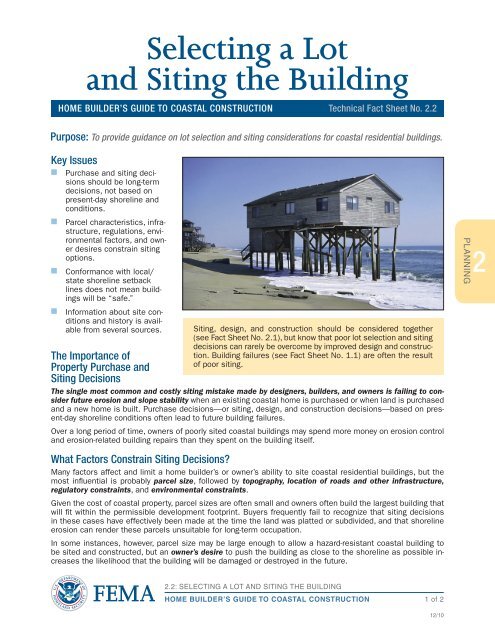FEMA P-499: Home Builder's Guide to Coastal Construction
FEMA P-499: Home Builder's Guide to Coastal Construction
FEMA P-499: Home Builder's Guide to Coastal Construction
Create successful ePaper yourself
Turn your PDF publications into a flip-book with our unique Google optimized e-Paper software.
Selecting a Lot<br />
and Siting the Building<br />
HOME BUILDER’S GUIDE TO COASTAL CONSTRUCTION Technical Fact Sheet No. 2.2<br />
Purpose: To provide guidance on lot selection and siting considerations for coastal residential buildings.<br />
Key Issues<br />
n Purchase and siting decisions<br />
should be long-term<br />
decisions, not based on<br />
present-day shoreline and<br />
conditions.<br />
n Parcel characteristics, infrastructure,<br />
regulations, environmental<br />
fac<strong>to</strong>rs, and owner<br />
desires constrain siting<br />
options.<br />
n Conformance with local/<br />
state shoreline setback<br />
lines does not mean buildings<br />
will be “safe.”<br />
n Information about site conditions<br />
and his<strong>to</strong>ry is available<br />
from several sources.<br />
The Importance of<br />
Property Purchase and<br />
Siting Decisions<br />
Siting, design, and construction should be considered <strong>to</strong>gether<br />
(see Fact Sheet No. 2.1), but know that poor lot selection and siting<br />
decisions can rarely be overcome by improved design and construction.<br />
Building failures (see Fact Sheet No. 1.1) are often the result<br />
of poor siting.<br />
The single most common and costly siting mistake made by designers, builders, and owners is failing <strong>to</strong> consider<br />
future erosion and slope stability when an existing coastal home is purchased or when land is purchased<br />
and a new home is built. Purchase decisions—or siting, design, and construction decisions—based on present-day<br />
shoreline conditions often lead <strong>to</strong> future building failures.<br />
Over a long period of time, owners of poorly sited coastal buildings may spend more money on erosion control<br />
and erosion-related building repairs than they spent on the building itself.<br />
What Fac<strong>to</strong>rs Constrain Siting Decisions?<br />
Many fac<strong>to</strong>rs affect and limit a home builder’s or owner’s ability <strong>to</strong> site coastal residential buildings, but the<br />
most influential is probably parcel size, followed by <strong>to</strong>pography, location of roads and other infrastructure,<br />
regula<strong>to</strong>ry constraints, and environmental constraints.<br />
Given the cost of coastal property, parcel sizes are often small and owners often build the largest building that<br />
will fit within the permissible development footprint. Buyers frequently fail <strong>to</strong> recognize that siting decisions<br />
in these cases have effectively been made at the time the land was platted or subdivided, and that shoreline<br />
erosion can render these parcels unsuitable for long-term occupation.<br />
In some instances, however, parcel size may be large enough <strong>to</strong> allow a hazard-resistant coastal building <strong>to</strong><br />
be sited and constructed, but an owner’s desire <strong>to</strong> push the building as close <strong>to</strong> the shoreline as possible increases<br />
the likelihood that the building will be damaged or destroyed in the future.<br />
2.2: SELECTING A LOT AND SITING THE BUILDING<br />
HOME BUILDER’S GUIDE TO COASTAL CONSTRUCTION<br />
1 of 2<br />
12/10<br />
PLANNING<br />
2


